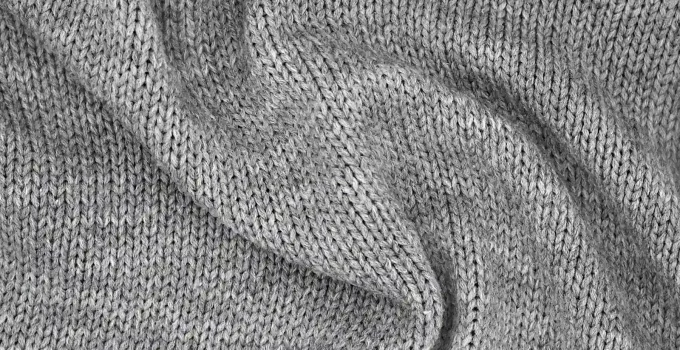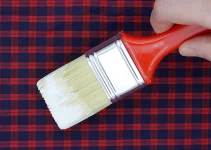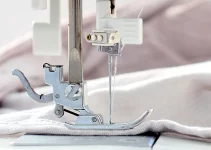In my opinion, the answer to the question is acrylic itchy should be that it can be itchy for some people but it might be completely soft and comfortable for others.
You won’t really know until you try it yourself.
I can say that it’s itchy for me, especially at a high percentage, and my boyfriend could say that it’s wonderfully comfortable and soft for him and that he loves how well it retains heat.
We can’t say that the same goes for everyone, especially when it comes to synthetic fibers and filaments. People will have different experiences because we’re all so different.
It’s up to you to decide if you want to take a chance on clothes made with acrylic or not.
Since acrylic was developed as a substitute for knitted wool, it’s totally understandable that we would want to know what its characteristics are.
This substitute for knitted wool has a generally warm, wool-like touch and it was and is used widely as a wool substitute, especially for knitwear.
However, nowadays, acrylic is often blended with wool and other natural fibers to reduce the cost of a wool garment.
It is often used in athletic products (tracksuits, hoodies, pants). It benefits from heat and shape-retention, being crease-resistant. And it has a low level of water absorption.
All that also makes it harder to give a definitive answer to the question of whether acrylic is itchy or not.
I guess I’ll just end up saying that a smaller percentage of acrylic in a fabric blend will likely cause no itchiness but things are more questionable at a high percentage of acrylic.
Anyway, I think the easiest way to answer this question for each of us individually is to try it out ourselves.
Is Acrylic Itchy? Yes and No
The most important information that we must be aware of is that polyester, acrylic, and nylon are all plastics.
They belong to the main group of synthetics.
Thus, what we must clearly be aware of is that acrylic is not a natural fabric.
Acrylic is an entirely synthetic material, a man-made fabric that comes from petroleum or coal-based compounds.
Well, synthetics are still the fabrics we’ll come across most often in stores so we’re right to ask questions like is acrylic itchy. To which I would say that all synthetics can be itchy for some but perfectly wonderful and comfortable for others.
Acrylic is usually found in: sweatshirts, sweaters, gloves, boot liners, athleticwear.
If you can notice a commonality, that’s the fact that acrylic is found in clothes and footwear that is meant to keep us warm.
It is well known for its ability to retain heat. It’s also known as an outdoor upholstery fabric.
So, we could call acrylic the synthetic, man-made replacement of wool.
Well, wool can also be itchy so I also say that acrylic can be itchy.
For example, wool can either feel cozy and soft or it can feel itchy. That depends on its quality and the strength of its fibers. Wool fibers have a scaly surface and that can lead to irritation when it makes contact with the skin.
We could also say that a high percentage of acrylic in a fabric blend can be itchy.
It can also be soft, just as it’s the case with wool, its natural counterpart, but it can become itchy at a high percentage.
However, there are a lot of people who are ecstatic with the heat retaining properties of acrylic so I totally recommend giving it a try. In most cases, it won’t be itchy.
Is acrylic as itchy as wool?
It’s absolutely true that wool still has a reputation for being itchy, uncomfortable, and even scratchy.
Indeed, some wool fibers can be itchy and scratchy.
It’s all about the quality and strength of its fibers.
Some wool can irritate the skin. But not all wool is itchy. For example, merino wool fibers are smaller and smoother in their surface. They bend when they touch the skin. So this particular type of wool is not itchy.
The same can be the case with acrylic.
In a high percentage, it can be itchy for some people.
On the other hand, we can say that some of us have worn wonderful clothes that contained acrylic fibers.
Cheaper acrylic tends to have a rougher feel.
Thus, a high quality acrylic yarn can be wonderful to work with. It’s also hypoallergenic. And some people will love working with acrylic for baby items due to these reasons and the easy care that characterizes it.
Overall, acrylic cannot be as itchy as wool, that’s for sure. But there’s also wool that isn’t itchy. Both can be true.
What is acrylic yarn good for?
If you are a crafter that loves making its own projects and objects via knitting and crocheting, then you might be interested in the use of acrylic yarns.
I would recommend them for beginners and they can be great for knitting and crocheting.
These yarns can be versatile and affordable. On the other hand, advanced fiber artists might disregard the use of acrylics in favor of natural fibers.
Also, those who want to protect the environment, will always consider natural fibers.
Even so, acrylic yarns are easy to work with, versatile, affordable, and easily accessible. Still, look for higher quality yarns to ensure that they’re soft and don’t have a rough feel.
Cheaper acrylic yarns will have a rougher feel.
If you are interested in knitting and crocheting but you’re still a beginner, you’ll be pleased to know that acrylic yarn has several uses.
It is great for blankets. We can make them in a variety of colors and textures. Plus, they have a low price point and are durable. A blanket can last for decades.
It’s also good for winter wear. They will keep us very warm but don’t offer as much protection from the elements.
Plus, most acrylic yarns are washing machine safe, they won’t shrink.
A Short Introduction to Synthetics
Polyester, acrylic, and nylon are all plastics. The fibers were primarily derived from coal and oil-based raw materials.
However, the thing with synthetic fabrics (fossil-based fibers) is not that they’re only bad for our planet. We could estimate that natural fibers (cotton, wool, wood-based fibers ) represent around a quarter, more or less, of today’s global fiber market.
Synthetic fibers increasingly come under scrutiny for their fossil origin, their high emissions, release of polluting microfibers into the ocean.
These fossil-based fibers can also be bad for our skin.
According to this article, while any fiber can cause a rash, we’re more likely to get an itchy, red area or scaly skin from clothes made with synthetics, like polyester, rayon, nylon, spandex, acrylic, rubber.
The advantage of wearing natural fabrics is that they’re breathable.
On the other hand, synthetics don’t breathe as well as natural fibers. That makes us sweat more, which can lead to itchiness. I absolutely have sensitive skin so I must always watch out for the type of fabrics I’m wearing, especially in warm weather. It can be an advantage if we can sometimes make our own clothes because we have better options and we can choose whatever is best for our skin.
The dye or other chemical in the clothing can also cause problems.
For example, if we’re allergic to nickel, we might get an itchy reaction when the jeans button touches our skin.
I gave you this example to illustrate that not everyone reacts the same. We’re all different and our skin types are totally different and so are our reactions.
We could say that the answer to the question is acrylic itchy might be yes for some of us but there are several factors that will make it perfectly comfortable for other people.
Acrylic fibers: a shot history
The height of acrylic fibers took place in the 1950s. Around that time, people were looking for fabrics that were easy-care.
We can definitely say that acrylic belongs to the category of easy-care fabrics and that increased its popularity.
Thus, it became a wool substitute for knitwear and across almost all market levels.
However, this boom period came to an end by the late 1960s.
Suddenly, acrylic became a cheap substitute with a tendency to pill. Pills are the name we give to small, firm balls of lint that form on the surface of clothing or on blankets, etc. Pills are the results of normal wear and tear.
Clothes made from wool, cotton, polyester, acrylic and other synthetics tend to pill more readily than denim, linen, or silk. So, it’s not a negative effect only for synthetics.
Still, even if we might say that there was a small decline in the 1960s for its popularity, acrylic is still very much present in our lives.
Nowadays, it is blended with wool and other natural fibers. This blend is meant to reduce the cost.
And it’s also used in athletic clothes.
Today, production is centered in the Far East, Turkey, India, Mexico and South America. There are also a number of European manufacturers that are still around.
Moreover, China is the global leader, producing more than 30% of the world’s acrylic fabric and apparel.
Acrylic properties
Since it’s a wool substitute, its heat retention capability is a major characteristic.
Moreover, it’s also crease-resistant. It retains its shape really well so we can say why it would be highly used in the manufacturing of athletic clothes.
Plus, it has a low level of water absorption. It has the benefit of quickly wicking moisture to the surface for it to quickly evaporate and dry.
All in all, it’s resilient, durable and low-maintenance.
All these properties amount to the fact that acrylic fiber production is mostly used in the garment industry. A lesser percentage is destined for furnishing fabrics. And an even smaller amount is destined for an industrial end use.
Modacrylic fibers
A modified form of acrylic is called modacrylic. It is primarily a German development first introduced in the early 1940s. It was produced on a large scale from 1954 by Bayer AG.
I wanted to mention modacrylic because it’s quite interesting with some amazing properties.
It is actually used for flame-retardant garments.
It is used for children’s wear and baby wear, soft toys, fake fur, and wigs.
Modacrylic is resistant to moths, mildew, and creasing during wear.
However, no matter how wonderful these properties remain and the fact that most of us end up wearing garments with a certain percentage of acrylic, which naturally leads us to ask the question is acrylic itchy, there are other factors we might be interested in considering.
Acrylic manufacturing remains energy-intensive. It also involves highly toxic substances, which require careful storage, handling, and disposal.
Another thing we might want to be informed about is acrylonitrile. Acrylonitrile is used extensively as a raw material in the manufacture of acrylic fibers, plastic, and synthetic rubbers.
If you want to know more about this key acrylic ingredients, you can read everything here.
Is acrylic sustainable?
I would call acrylic an unsustainable choice.
The production relies heavily on the petrochemical industry.
Acrylic is a synthetic and we cannot say that synthetics as a whole are sustainable since they are dependent on fossil fuel extraction.
The production is also energy intensive and it involves highly toxic substances.
However, us consumers are not responsible for it. Manufacturers are. It’s their job to pursue sustainability and offer it at prices that the majority of us can afford.
And, since acrylic is still so highly used in the manufacturing of various clothes, headwear, footwear, and athletic clothes, it’s only natural that we would pose the question is acrylic itchy, and the answer is that it can be itchy in a high percentage but for most people it will feel comfortable and soft.




